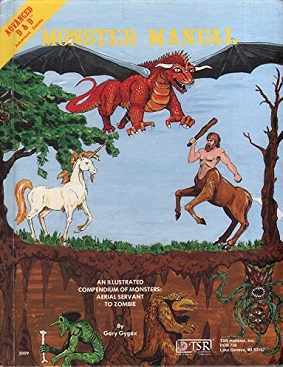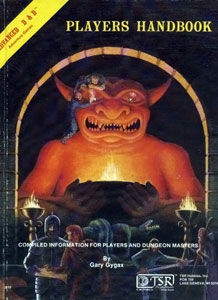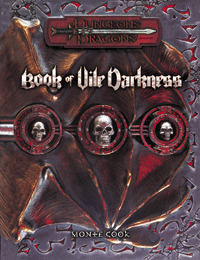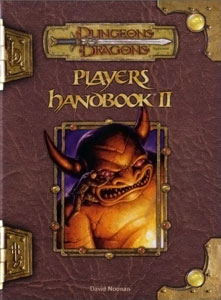
Dungeons & Dragons is a fantasy tabletop role-playing game (RPG) originally designed by Gary Gygax and Dave Arneson. The game was first published in 1974 by Tactical Studies Rules, Inc. (TSR). It has been published by Wizards of the Coast since 1997. The game was derived from miniature wargames, with a variation of the 1971 game Chainmail serving as the initial rule system. D&D's publication is commonly recognized as the beginning of modern role-playing games and the role-playing game industry, and also deeply influenced video games, especially the role-playing video game genre.

Planescape is a campaign setting for the Dungeons & Dragons fantasy role-playing game, designed by Zeb Cook, and published in 1994. It crosses numerous planes of existence, encompassing an entire cosmology called the Great Wheel, as developed previously in the 1987 Manual of the Planes by Jeff Grubb. This includes many of the other Dungeons & Dragons worlds, linking them via inter-dimensional magical portals.

The Monster Manual is the primary bestiary sourcebook for monsters in the Dungeons & Dragons fantasy role-playing game, first published in 1977 by TSR. The Monster Manual was the first hardcover D&D book and includes monsters derived from mythology and folklore, as well as creatures created specifically for D&D. Creature descriptions include game-specific statistics, a brief description of its habits and habitats, and typically an image of the creature. Along with the Player's Handbook and Dungeon Master's Guide, the Monster Manual is one of the three "core rulebooks" in most editions of the D&D game. As such, new editions of the Monster Manual have been released for each edition of D&D. Due to the level of detail and illustration included in the 1977 release, the book was cited as a pivotal example of a new style of wargame books. Future editions would draw on various sources and act as a compendium of published monsters.

The Player's Handbook is a book of rules for the fantasy role-playing game Dungeons & Dragons (D&D). It does not contain the complete set of rules for the game, and only includes rules for use by players of the game. Additional rules, for use by Dungeon Masters (DMs), who referee the game, can be found in the Dungeon Master's Guide. Many optional rules, such as those governing extremely high-level players, and some of the more obscure spells, are found in other sources.

The Dungeon Master's Guide is a book of rules for the fantasy role-playing game Dungeons & Dragons. The Dungeon Master's Guide contains rules concerning the arbitration and administration of a game, and is intended for use by the game's Dungeon Master.

Tomb of Horrors is an adventure module written by Gary Gygax for the Dungeons & Dragons (D&D) role-playing game. It was originally written for and used at the 1975 Origins 1 convention. Gygax designed the adventure both to challenge the skill of expert players in his own campaign and to test players who boasted of having mighty player characters able to best any challenge. The module, coded S1, was the first in the S-series, or special series of modules. Several versions of the adventure have been published, the first in 1978, and the most recent, for the fifth edition of D&D, in 2017 as one of the included adventures in Tales from the Yawning Portal. The module also served as the basis for a novel published in 2002.

Ravenloft is an adventure module for the Dungeons & Dragons (D&D) fantasy role-playing game. The American game publishing company TSR, Inc. released it as a standalone adventure booklet in 1983 for use with the first edition Advanced Dungeons & Dragons game. It was written by Tracy and Laura Hickman, and includes art by Clyde Caldwell with maps by David Sutherland III. The plot of Ravenloft focuses on the villain Strahd von Zarovich, a vampire who pines for his lost love. Various story elements, including Strahd's motivation and the locations of magical weapons, are randomly determined by drawing cards. The player characters attempt to defeat Strahd and, if successful, the adventure ends.

Keith Baker is a game designer and fantasy novel author. In addition to working with Wizards of the Coast on the creation of Eberron, he has also contributed material for Goodman Games, Paizo Publishing and Green Ronin Publishing. In 2014, Baker and Jennifer Ellis co-founded the indie tabletop game company Twogether Studios.

Eberron Campaign Setting is a hardcover accessory for the 3.5 edition of the Dungeons & Dragons fantasy role-playing game.
The RPGA, was initially part of the organized play arm of TSR, Inc and later of Wizards of the Coast. From 1980 to 2014, it organized and sanctioned role-playing games worldwide. In 2014, it was replaced with the D&D Adventurers League.

The Forgotten Realms Campaign Setting is a role-playing game sourcebook first published by TSR in 1987 for the first edition of the fantasy role-playing game Advanced Dungeons & Dragons that describes the campaign setting of the Forgotten Realms. It contains information on characters, locations and history. Various revised and updated editions have been produced over the years.

Book of Vile Darkness is an optional supplemental sourcebook for the 3rd edition of the role-playing game Dungeons & Dragons. The book was written by Monte Cook and published by Wizards of the Coast on October 1, 2002. Described as a "detailed look at the nature of evil," it was the first Dungeons & Dragons book labelled for mature audiences.

The Hidden Shrine of Tamoachan is an adventure module for the Dungeons & Dragons (D&D) fantasy role-playing game, set in the World of Greyhawk campaign setting for use with the 1st edition Advanced Dungeons & Dragons rules. It is the first in the C-series of modules, a set of unrelated adventures originally designed for competitive play, with the C representing the first letter in the word competition.

Heroes of Battle is a hardcover supplement to the 3.5 edition of the Dungeons and Dragons role-playing game.

Player's Handbook II is the title of a third edition Dungeons & Dragons supplement. It is a handbook of rules and guidelines for the Dungeons & Dragons role-playing game. As the name implies, the book is a supplement to the edition's Player's Handbook. It introduces supplemental rules, new spells and new classes.

Sigil is a fictional city and the center of the Planescape campaign setting for the Dungeons & Dragons fantasy role-playing game.

The Magic Item Compendium is a sourcebook written for the 3.5 edition of the Dungeons & Dragons fantasy role-playing game.
David Noonan is an author of several products and articles for the Dungeons & Dragons fantasy role-playing game from Wizards of the Coast.

Eberron: Rising from the Last War is a sourcebook that details the Eberron campaign setting for the 5th edition of the Dungeons & Dragons fantasy role-playing game. Jeremy Crawford, co-lead designer of the book, said the book "is the size of one of the core rule books of the game, it is jam packed".
















